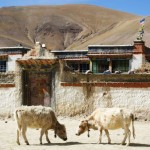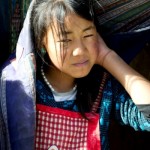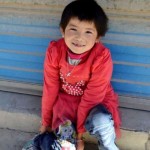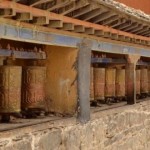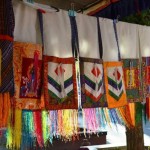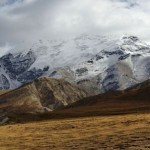Seven days in Tibet – episode 2
TINGRI
In the morning I experience my first shower using wet wipes, which is more comforting than I have expected. I have no choice, the taps from the Communist camp’s bath are a natural extension of the cold Pandora waterfalls, I have just crossed. I knew from home in these conditions contacting a cold could take unexpected forms and is not easy to heal, showers are even contraindicated. For me it’s catastrophic. Therefore, the wet wipes stock has high demands. All packages or sealed bottles we have in the luggage are swollen, ready to explode. Also our brains. However, with only a Nurofen, headache and slight dizziness pass as though they were never.
Next target: Tingri, a village served on the world’s highest plateau, the true Tibetan delicatessen of our journey. The winding road starts on the brown plateau, with ups and downs, which gives us landscapes we don’t found in any other place on Earth. We enjoy piece by piece, our driver as a Chinese hits singer slows or stops whenever he hears wow! from the back seats, not understanding a word from our. From this reason we forgive his bronchial cleaning, which he does periodically by the window of the moving car. In fact, all Tibetans and Chinese are very uninhibited when it comes to their body health. Following the principle it is better to give them out than to keep them inside. Let’s come back to the beautiful part of our story.
The azure sky ever seen, powdered with candy floss clouds, a such clear light that lets you to observe clearly even the furthest top. No wonder that in the Lalung La Pass, the landmark shows 5.050m and other one 5.420m. From Lalung you can see the Shisapangma top (8.013m) and also other five snowy 7000m tops. Here, the sunglasses are no longer only a fashion accessory, but a necessity, especially if you have a degree of UV protection as high as possible.
Gates decorated with hundreds of prayer flags meters lets you know that you are in a canyon. A color accent in the absence of any other traces of foliage. Rectangular strips of blue, white, red, green, yellow cloth, representations of the five elements – sky, air, fire, water and earth – strung on the string, wave in the wind and spread through the four cardinals the positive energy generated by the prayers and symbols written on them. Is said the spiritual vibrations protect from evil and bring harmony to all those touched by breeze purified by mantras. Gates are surrounded by hundreds of small stupas made by all that arrive here. Some stones placed one above another, in the form of a cone with a small personal object in the middle, take the place of its own altar. Here and there, one of the stupas is crowned by a pair of yak horns that induce a bit of drama to the atmosphere with colorful flags and small pieces of paper printed with mantras, also carried by the wind. A kind of spiritual confetti, if I’m allowed.
- Șapte zile în Tibet – Tingri
- Șapte zile în Tibet – Tingri
- Șapte zile în Tibet – Tingri
- Șapte zile în Tibet – Tingri
- Șapte zile în Tibet – Tingri
- Șapte zile în Tibet – Tingri
This land needs all the prayer flags in the world. Sprinkled throughout the whole field, the ruins are reminiscent of ’60s cultural revolution, when Red Guards destroyed many of the Buddhist monasteries, killing or exiling almost all the monks. In the villages we have crossed, the white houses of earth and stone, with wall fences covered with yak compost to dried, fly the Chinese flag at the gates. Opponents receive heavy fines and ultimately are demolished and moved to cold blocks from the cities, breaking them of where they were born and from their traditions. And that’s a small part of the cultural and religious genocide achieved. But that’s a long discussion.
We arrive in Tingri, a friendly settlement you can take in at a glance, two rows of low houses on the one side of the road we climbed to 4.350m. Residents who sell their goods, children crying, dogs and cows feeding on the dumps, or free horses harnessed to wagons, cars and tractors animate the street. First stop, let’s get lunch. Behind of a dirty blanket that is in fact the door, decorated with srivatsa – the node of the endless reincarnations – I get the most authentic and delicious Tibetan food: already mentioned spicy ginger soup and a yak chili with vegetables and rice with aromatic masala tea. Do not forget the fluffy thing, a sort of sponge pancake, with apple or banana, which will become the burden of our group. Here, meals are prepared at dry yak dung fire, wood being a rare commodity. Sun’s heat is used to heat the tea water in a very ingenious way. Panel boards having the form of the windshield sun visors focuse light on the bottom of the teapot placed two feet above them. May not be more eco than that. Columns, beams, wooden tables, all painted in bright colors, with floral models, paintings of religious scenes, soft welcoming divans, a stove in the middle of the room, the habitual thermos with jasmine tea invites you to a sweet laziness. But we do not have time for that. Everest calls us, presenting on behalf of Tibetan, Chomolungma, Goddess Mother of the World, and eternal snows, swept away by the wind, like a reeky volcano.
The slow climbing for few minutes in the air with only 58% oxygen and the view of our planet’s highest mountains are breathtaking. Lined to the horizon, Everest (8.848m), Lhotse (8.516m), Makalu (8.481m) and Cho Oyu (8.201m), that four of the highest mountains on Earth, along with two other 7000m and 6000m tops, deeply impressed our hungry retinas and our cameras’ sensors. I linger long on this peak, leaving me respite for fully enjoy the hiking climax, until the tops turn sunlight at sunset. Sitting on a stone, with my eyes up to the highest point that you can see in this world, I realize again how important we believe we are. A show hard to forget, sealed with a butter tea, a salty tea with nac butter, the female of the yak – with brie cheese taste that takes place for a successfully dinner. A tea that you can find or interesting, drinking for a few times, or totally disgusting. But you can’t say that you were in Tibet if you have not tasted.
In the hotel from Tingri I understand why a front flashlight is very helpful. Electricity is only from eight to the midnight, aspect that awakens my memories of ended ages. Roads to the bathroom without windows and without a flashlight would have been an adventure.
As my two fellows’ status shows no sign of improvement, on the contrary, we take the painful decision to abandon the night of the Everest Base Camp. For many, the night in a Tibetan tent laid down at the foot of Everest was the holiday peak time, but we can’t joke with the altitude sickness. It may, however, the worse way, because our guide considers appropriate our immediate return to Nepal after only two days of staying in Tibet, scared of a possible worsening of those two colleagues state to cerebral edema and probably at precious indications coming from the Chinese part, which certainly relate all our movements. We cannot leave them behind for a day because of our common group visa and the control fixed points on the route which requires the “all or no one”.
- Șapte zile în Tibet – Tingri
- Șapte zile în Tibet – Tingri
- Șapte zile în Tibet – Tingri
- Șapte zile în Tibet – Tingri
- Șapte zile în Tibet – Tingri
Close my eyes and wait. It’s allright, I can sleep peacefully, Everest is prominently and will remain so, even with the Base Camp unchecked.






